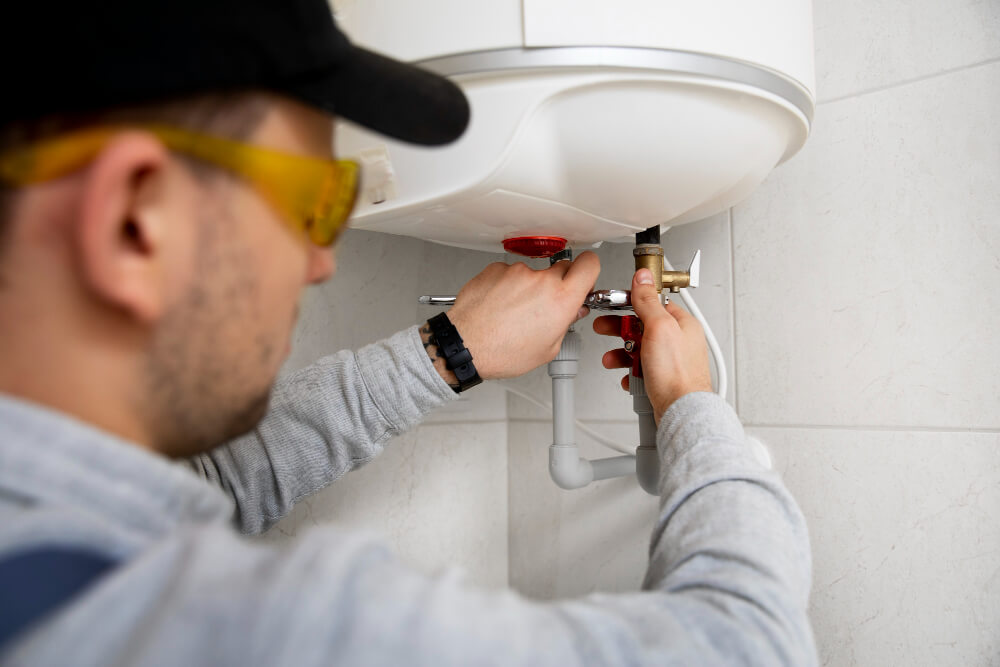A malfunctioning water heater can quickly disrupt your daily routine, especially when there’s no hot water for showers or cleaning. One of the most common causes is a problem with the pilot light, a small flame that ignites the burner to heat water.
This guide covers how the pilot light works, common reasons why the water heater pilot light not working, troubleshooting steps, and maintenance tips to prevent future issues.
What Is a Pilot Light and How Does It Work in a Water Heater?
A pilot light is a small, constantly burning flame that ignites the primary burner of a gas water heater when heat is needed. It’s essentially the ignition source that signals your system to heat the water stored in the tank. When your water heater’s thermostat senses that the water temperature has dropped below the set level, it releases gas to the burner, and the pilot light ignites the flame that heats the water.
Most modern gas water heaters feature a thermocouple, a safety device that detects whether the pilot light is burning. If it goes out, the thermocouple automatically shuts off the gas supply to prevent leaks. When functioning properly, this system ensures efficiency and safety. However, if any component fails, you might find the pilot light on water heater went out, causing a complete loss of hot water.
Top 5 Signs That Indicate Your Pilot Light Is Out on the Water Heater
When your water heater stops working, the first clue often lies in the pilot light. Here are the most common signs that it’s out or malfunctioning:
- No Hot Water: The most obvious sign is a complete lack of hot water. Since the pilot light is essential for ignition, no flame means no heat.
- Cold or Lukewarm Water: Sometimes, the light flickers out intermittently, leading to inconsistent water temperatures.
- No Flame Visible: Open the access panel and check for the small blue flame. If you don’t see it, the pilot light is out.
- Clicking or Hissing Sounds: These noises might indicate gas is flowing but not igniting, suggesting a faulty pilot or thermocouple.
- Smell of Gas (Warning): If you smell gas, do not attempt to relight the pilot light. Turn off the gas supply and call a professional immediately for safety.
If these symptoms persist, it’s time to start water heater troubleshooting pilot light to determine the root cause.
Top 7 Reasons Why the Water Heater Pilot Light Isn’t Working
When your water heater pilot not staying lit, several mechanical or environmental factors could be responsible. Let’s break down the most common causes:
- Dirty or Clogged Pilot Orifice
- Faulty Thermocouple
- Gas Supply Issues
- Drafts or Airflow Problems
- Defective Control Valve
- Condensation or Moisture Buildup
- Old or Worn-Out Water Heater
1. Dirty or Clogged Pilot Orifice
Over time, dust, soot, or debris can accumulate in the pilot orifice, restricting gas flow to the flame. A weak or irregular flame can easily extinguish itself, especially in drafty areas. Cleaning the orifice with compressed air or a small brush can often restore proper function.
2. Faulty Thermocouple
The thermocouple is a small copper rod positioned near the pilot flame. Its job is to sense whether the pilot light is burning. If it’s bent, dirty, or defective, it can falsely signal that the flame is out, shutting off the gas supply. Replacing or adjusting a faulty thermocouple usually solves this problem.
3. Gas Supply Issues
If your gas valve is partially closed or the line is obstructed, the pilot won’t receive enough fuel to stay lit. This could result from low gas pressure, air trapped in the line, or a faulty regulator. Always check other gas appliances in your home to see if they’re functioning normally to rule out a larger gas supply issue.
4. Drafts or Airflow Problems
Even a light breeze from an open window or ventilation duct can blow out the pilot light. This is especially common in basements or garages. Ensuring the area around your water heater is free from strong drafts can prevent the flame from being extinguished.
5. Defective Control Valve
The gas control valve regulates the flow of gas to both the pilot and the main burner. If it’s malfunctioning, the pilot might not receive consistent gas flow. This issue usually requires professional inspection or replacement of the control valve.
6. Condensation or Moisture Buildup
After running your water heater for long periods or during humid weather, condensation can drip onto the pilot flame, extinguishing it. Keeping the area dry and well-ventilated helps prevent this.
7. Old or Worn-Out Water Heater
If your unit is over ten years old, repeated pilot light issues may indicate it’s nearing the end of its lifespan. Wear and tear on internal components can make consistent ignition difficult, signaling it may be time for an upgrade.
How to Troubleshoot Water Heater Pilot Light Problems?
Before calling a plumber, you can perform some safe and simple troubleshooting steps. Here’s how to inspect the issue methodically:
1. Check for Gas Supply
Make sure the gas valve near your water heater is in the “ON” position. If you suspect a gas supply problem, test another gas appliance in your home. If they also aren’t working, contact your gas provider.
2. Inspect the Pilot Light Area
Remove the access panel and look for dirt, corrosion, or moisture around the pilot assembly. Clean the area gently with a dry cloth.
3. Examine the Thermocouple
Ensure the thermocouple tip is positioned correctly in the flame. If it looks sooty or damaged, it might need cleaning or replacement.
4. Check for Drafts
Turn off any nearby fans, and close windows or vents that could blow directly onto the water heater.
5. Listen for the Click
When pressing the pilot button, you should hear a faint clicking or hissing sound, indicating gas flow. If not, there might be a valve or gas line issue. Taking these steps helps pinpoint the problem and determine whether you can fix it yourself or need professional help.
How to Fix the Water Heater Pilot Light Not Working?
Once you’ve identified the likely cause, you can proceed with the appropriate fix. Follow these steps carefully to relight or repair the pilot light:
Step 1: Turn Off the Gas Supply
For safety, switch the gas control knob to “OFF” and wait at least five minutes to allow any residual gas to dissipate.
Step 2: Locate the Pilot Light Assembly
Find the pilot burner, usually beneath a small metal cover. You should see a control knob labeled “OFF,” “PILOT,” and “ON.”
Step 3: Relight the Pilot
Turn the knob to “PILOT” and press it down while holding a lighter or match to the pilot opening. Continue pressing for about 30 seconds until the flame remains steady. If the pilot light is out on the water heater and doesn’t stay lit after several attempts, move to the next step.
Step 4: Clean or Replace the Thermocouple
If your pilot flame lights but quickly goes out, the thermocouple may be dirty or failing. Use fine-grit sandpaper to clean the tip gently, or replace it if damaged.
Step 5: Adjust the Pilot Flame
A properly working pilot light should produce a strong blue flame with a small yellow tip. If it’s weak or uneven, check for blockages in the pilot tube or orifice and clean them carefully.
Step 6: Inspect the Control Valve
If the gas doesn’t flow even after relighting attempts, the control valve may need professional servicing. Don’t attempt to repair this component yourself—it’s best handled by a licensed technician.
Step 7: Test the Water Heater
Once the pilot light stays lit, turn the knob back to the “ON” position and wait for the burner to ignite. After about 30 minutes, check if the water is heating properly.
By following these steps, most homeowners can safely restore their hot water supply without major water heater repairs.
Preventive Tips to Keep Your Water Heater Pilot Light Working
Prevention is key to avoiding frequent relighting or costly repairs. Here are some expert maintenance tips:
- Regular Cleaning: Clean the pilot assembly and burner area every few months to prevent dust buildup that can disrupt the flame.
- Annual Inspection: Have a professional plumber inspect your water heater annually. They can identify issues like corrosion, weak thermocouples, or gas leaks before they worsen.
- Proper Ventilation: Keep the water heater area well-ventilated but free from strong drafts. Ensure the exhaust vent isn’t blocked or damaged.
Temperature Settings: Maintain your water heater temperature between 120°F and 130°F to reduce condensation and energy strain on components. - Replace Aging Parts: If you notice repeated pilot failures, consider replacing old components such as the thermocouple or gas control valve. This can extend the heater’s lifespan and improve reliability.
- Avoid Moisture Exposure: Keep the area around your water heater dry. Excess moisture or flooding can extinguish the flame and corrode parts.
By following these preventive measures, you can minimize the chances of your pilot light going out and keep your water heater operating efficiently year-round.
Conclusion
A malfunctioning pilot light can be a frustrating yet common water heater issue. Whether caused by a dirty orifice, a faulty thermocouple, or a gas supply problem, understanding how to diagnose and fix it empowers you to restore your system quickly. Regular cleaning, proper ventilation, and professional water heater maintenance with the help of Eco Plumbers, Electricians, and HVAC Technicians are the best defenses against recurring problems.
If you’ve tried all troubleshooting steps and your water heater pilot light won’t stay lit, it may be time to contact a licensed technician from us at (937) 697-1223 to inspect your unit. A small maintenance effort today ensures consistent hot water and a safer, more efficient home tomorrow.









